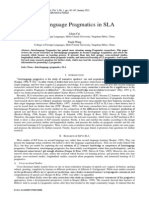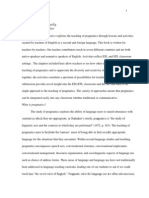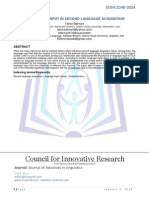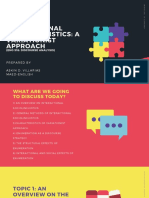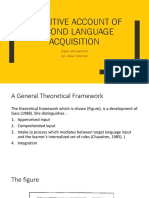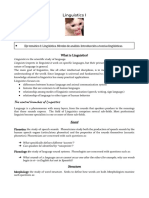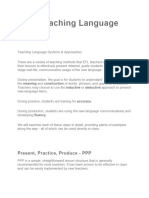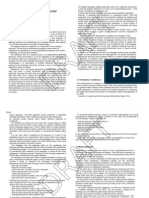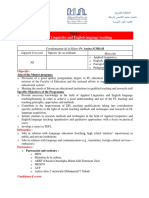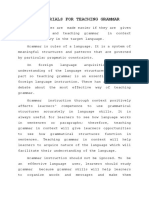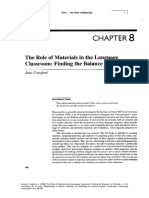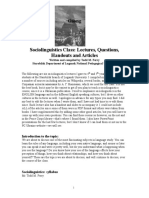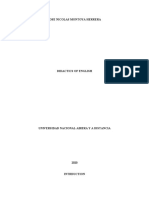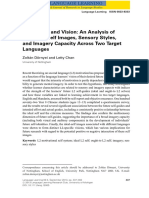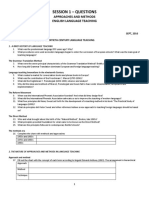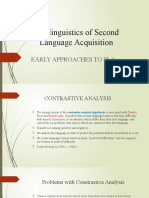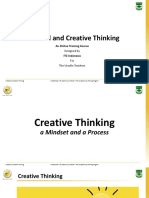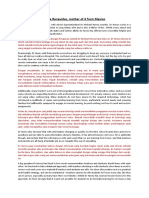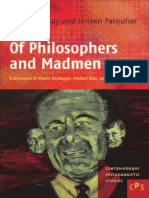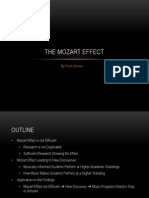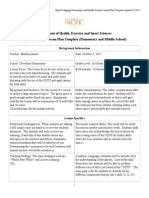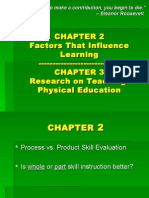SLA: Error Analysis/ Taxonomies
Error Analysis as the Basis for the Design and Development of ICALL
3/6/2014
Rachel Brooks Gorky Cruz Ling 561/761
�Can computers correct language errors in L2 output? How does EA inform ICALL design?
ICALL developers rely on the application of EA to determine a variety of design factors crucial to the successful development of an ICALL project, such as:
Determining intended users, language/language system, intended dialect or variety Error type feedback type correlations (e.g. sensitive correction) Generating accurate taxonomies through diagnosis (source or errors), prognosis (prediction of errors) and clearest description possible of error types which can enable NLP parsers to correctly assess L2 learner input and provide the appropriate feedback.
In order to better understand this, lets review how EA came about
3/6/2014
�1. The concept of Language Transfer
Language Transfer perspectives vary according to theoretical stances: Psychological Views
Behaviorist theory: Learning as a cumulative process (Skinner) TRANSFER: positive transfer (facilitation) vs. negative transfer (interference) The nature of the transfer process is revealed through the NNS output INTERFERENCE: retroactive inhibition vs. proactive inhibition Wholesale application of this framework to SLA is questionable lacks empirical evidence to support all its assumptions.
3/6/2014
�1. The concept of Language Transfer
Language Transfer perspectives vary according to theoretical stances: Linguistic Views
Behaviorist theory: Speech precedes Writing Speech as habit: stimulus-response connection is crucial to learning Language is a habit: An L2 requires the development of a new set of habits
3/6/2014
�2.
Enter Contrastive Analysis
Contrastive Analysis: Replacing a set of habits (L1) with another set of habits (L2)
Requires descriptions that compare the rules of both L1 and L2 North American CA: Emphasizes pedagogy (improvement of teaching, learning, classroom materials) and relates more closely to SLA European CA: More metalinguistic in scope, relates more closely to linguistics
3/6/2014
�2.
Enter Contrastive Analysis
Contrastive Analysis Hypothesis (CAH)
Process: (1)Structure by structure comparison of language systems (2) yields similarities and differences that make it possible to (3) predict easy and difficult areas for L2 learners. Assumptions:
(1) Language is a habit (2) L1 is the major source of error in SLA (3) Errors can be explained by the differences between L1 and L2 (4) The more L1 and L2 differ, the greater the chance for errors (5) Learners must concentrate on differences between L1 and L2 (6) Ease or difficulty in Learning correlate to the amount of differences or similarities between L1 and L2
3/6/2014
�2.
Enter Contrastive Analysis
Two competing CAH positions:
A priori/predictive/strong view: Relies on L1/L2 comparison to predict learning curve
* Falls out of favor once language learning is identified active rule formation and not simple imitation leading to habit formation * Challenges to the concept of difficulty
A posteriori/explanatory/weak view: Departs from analyses of learners recurring errors to explain their IL (interlanguage) forms. Is able to account for errors that go beyond the surrounding speech and those explained by L1 transfer
* Eventually influences the emergence of Error Analysis.
3/6/2014
�3. The Rise of Error Analysis
Seminal article by Corder (1967): The Significance of Learner Errors
Errors emerge as evidence of a system :: evidence of the state of a learners knowledge of the L2 Errors do not reflect faulty imitation, but rather learner systematization of L2, thus evidencing and underlying rulegoverned system ERRORS (systematic) vs. MISTAKES (one time, self correctable events) EA is similar to weak/explanatory CA, but it compares learner data to the TL Implemented in the classroom, with pedagogical goals
3/6/2014
�Error vs Mistake
Errors reflect competence Systematic Correcting errors concurs with CR (which focuses on what learners do not know)
3/6/2014
Mistakes reflect performance Self-correctable Correcting mistakes concurs with LA (which seeks to make explicit what the learner knows implicitly)
9
�3. The Rise of Error Analysis
So errors
Inform the teacher about what should be taught Inform the researcher about the course of learning Are an outcome of the learners L2 hypothesis testing What can errors do for ICALL designers?
3/6/2014
10
�4. EA Procedure
Gass & Selinker Collect Data Identify errors Classify errors Quantify errors Analysis of source Remediation (through
pedagogical intervention)
3/6/2014
Corder(1974) Collect Data Identify errors Describe errors Explain errors Evaluate errors
11
�4. EA Procedure
Within EA there are 2 types of errors:
Interlingual/NL dependent Intralingual/TL dependent
Caveats:
Schachter (1974) made a case for considering both errors and nonerrors The cause of an error may not be immediately apparent Correct usage is NOT (necessarily)= correct rule formation The etiology of any given error need not be exclusive to a single source EA does not directly account for avoidance EA based research has traditionally lacked longitudinal (developmental) scope, it has been mostly cross sectional (static) in nature
3/6/2014
12
�5. Correction in ICALL: Sources of Error
Interlingual (NL derived) Intralingual (developmental) Dodigovic
Transfer Intralingual interference Sociolinguistic situation Modality of exposure to TL Age Successions of approximative systems Universal hierarchy of difficulty AbiSamra
3/6/2014
Interlingual Intralingual Induced James
Transfer Transfer of learning Strategies of L2 learning Strategies of L2 communication Overgeneralization of TL linguistic material
13
Selinker
�5. Correction in ICALL
Fortunately, learners want to receive correction.
Consider the roles of Positive and Negative Evidence in correction (what about metalanguage?) Correction types: Recasts Stating the relevant linguistic rule Error type indication without recast Underlining Error count per line
3/6/2014
14
�5. Correction in ICALL
SLA theorists agree that noticing is the crucial event in error correction and language learning, because it fosters CR in the form of a cognitive comparison that incorporates new L2 information (Doughty 2001); similar to EA but deployed by the learner (James 1998).
3/6/2014
15
�5. Correction in ICALL
And so, error correction can be directed to raise either: Awareness Gained of something implicitly known Brought about through explication Linked to procedural knowledge
3/6/2014
Consciousness Gained of something previously unknown Linked to declarative knowledge
16
�5. Correction in ICALL
Degrees of error correction:
Intervention feedback (just informs the learner that theres an error) Correction proper (indirect negative evidence) Remediation (overt metalinguistic feedback)
3/6/2014
17
�6. Hands-on section: Questions to consider Is the language being judged by oral or written language standards? What dialect of the language is being used as standard?
3/6/2014
18
�6. Hands-on section: In your group
1. 2.
3.
Identify the errors in your passage Classify errors by linguistic (e.g. plural, verb tense) and/or surface structure (e.g. omission, addition) Explain the examinees errors
Are they errors or mistakes? What types of errors are present/absent? How do the errors fit into the taxonomies? Is it an error of correctness/appropriateness?
4. 5.
What type of feedback could be helpful to this learner? Are there ICALL opportunities/obstacles?
3/6/2014
19
�Analysis of Source/ Explanation of Error
Analysis of Source Psycholinguistic (Taylor) Sociolinguistic (Taylor) Epistemic (Taylor) Discourse (Taylor)
Competence Problems (Richards)
Interlingual/ Interference (Richards)/ Transfer (Lott) Errors
Intralingual (Richards)/ Development Errors
Unique Errors (Dulay and Burt)
Developmental Errors (Richards) Overgeneralization Errors Overextension of Analogy Ignorance of Rule Restrictions Transfer of Structure Incomplete Application of Rules Interlingual/ Intralingual Errors False Concept Hypothesized
Performance Problems (Richards)
Processing Problems
Communication Strategies
3/6/2014
20
�7. For discussion
1. 2. 3. 4. What types of labeling seem to be the most helpful? For what types of errors does Error Analysis seem most useful? How might the choice of task cause EA results to vary? Do NSs and NNSs label errors differently? What about people trained vs. those untrained to notice errors? 5. Ellis said that there is not a scale for language error difficulty. Would it be possible or useful to create a such a scale? What about a scale with a more specific application? 6. Based on the learner profiles, what is the place of Error Analysis in ICALL? 7. How can ICALL approach error correction at the suprasentential level? (See Simmons and Thurstun (1995) as cited in Dodigovic pp.177)
3/6/2014
21
�Examinee Background
Lang Sex Age Citizenship Birth Native Lang Primary Lang Yrs in Eng country in Last10 yrs Age began English Education
German
23
Germany
Germany
German
English
1 to 5
16 to 20
Prof degree
French
23
France
France
French
English
16 to 20
HS diploma
Russian
18
USA
Russia
Russian
English
6 to 10
11 to 15
HS diploma University degree University degree
Italian
34
Italy South Korea
Italy South Korea
Italian
Italian
1 to 5
25+
Korean
34
Korean
Korean
6 to 10
21 to 25
3/6/2014
22



